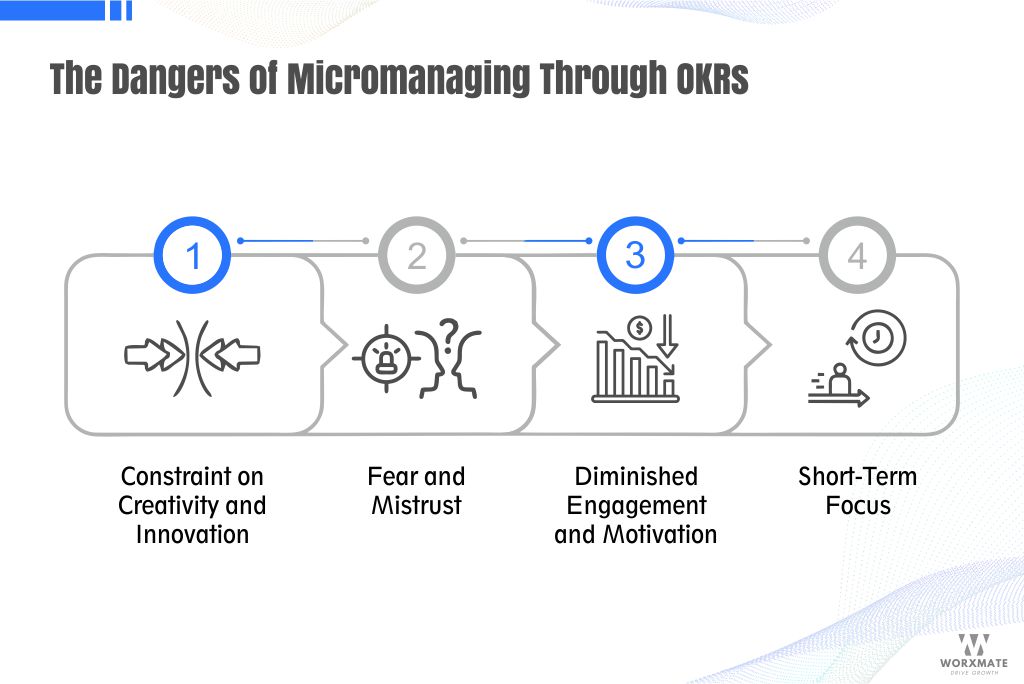In the dynamic world of modern management, adopting Objectives and Key Results (OKRs) has become increasingly popular as a method to align organizational goals and drive performance.
Initially conceived by Intel and popularized by companies such as Google, OKRs offer a framework for setting ambitious objectives and measurable results. However, a potential danger lies beneath this seemingly effective goal-setting tool: micromanagement.
Micromanagement is characterized by excessive control, invasive oversight, and a lack of trust in the abilities of employees to perform their tasks autonomously.
Micromanagers often feel the need to be involved in every decision and detail, resulting in stifled creativity, diminished morale, and reduced productivity among team members. A survey revealed that approximately 70% of workers consider quitting their jobs due to micromanagement, with 30% leaving as a result.
OKRs, on the other hand, are designed to provide clarity, focus, and alignment within an organization. Objectives articulate the overarching goals to be achieved, while Key Results serve as measurable outcomes that indicate progress toward those objectives.
When implemented correctly, OKRs empower employees to take ownership of their work, encourage collaboration, and foster a sense of purpose and direction.
The Intersection of Micromanagement and OKRs
Despite their potential benefits of OKRs, such as enhancing alignment and focus, they can become ground zero for micromanagement if misused by leaders or managers.
Micromanagers may see OKRs as a tool to exert control over their teams, damaging employee autonomy, creativity, and morale.
Instead of inspiring and empowering employees to achieve their goals, micromanaged OKRs can result in a culture of fear, resentment, and disengagement.
The Dangers of Micromanaging Through OKRs

Constraint on Creativity and Innovation
- Micromanagement within OKRs imposes strict boundaries on how objectives are defined and pursued, limiting the scope for creative thinking and innovative problem-solving.
- Employees may hesitate to explore unconventional approaches or propose novel ideas, fearing repercussions for deviating from predefined metrics or targets.
- By stifling creativity, micromanaged OKRs hinder the organization’s ability to innovate and differentiate itself in the marketplace, potentially compromising its competitive edge.
Cultivation of Fear and Mistrust
- Micromanaged OKRs create an environment where employees feel under constant surveillance, leading to heightened anxiety and reluctance to speak up or challenge the status quo.
- Fear of judgment inhibits open communication and collaboration, hindering collective problem-solving efforts.
- Lack of transparency and mutual respect erodes trust between employees and management, undermining morale, cohesion, and ultimately, organizational effectiveness.
Diminished Engagement and Motivation
- Micromanagement deprives employees of autonomy and ownership over their work, diminishing intrinsic motivation and job satisfaction.
- Feeling micromanaged can lead to a sense of disempowerment and disillusionment, resulting in decreased commitment to organizational goals and an increased likelihood of disengagement or burnout.
- Diminished motivation and engagement negatively impact employee performance and productivity, ultimately compromising the organization’s ability to achieve its objectives and sustain long-term success.
Short-Term Focus
- Micromanaging through OKRs prioritizes short-term outcomes and narrowly defined metrics over long-term strategic objectives, neglecting investments in foundational capabilities or future-oriented initiatives.
- Overemphasis on immediate results can lead to strategic misalignment, hindering the organization’s ability to adapt to evolving market dynamics and capitalize on emerging opportunities.
- By sacrificing long-term sustainability for short-term gains, micromanaged OKRs compromise the organization’s resilience.
Strategies for Mitigating Micromanagement in OKRs
To mitigate the risks of micromanaging through OKRs, organizations must prioritize cultivating a culture of trust, autonomy, and empowerment.
Leaders and managers should focus on providing clear expectations, guidance, and support rather than imposing strict controls and micromanaging every aspect of employees’ work.
Encouraging open communication, collaboration, and feedback channels fosters a sense of psychological safety and mutual respect among team members.
Providing training and education on effective leadership, goal-setting, and communication skills equips managers with the tools and knowledge to effectively lead their teams without micromanagement.
Empowering employees to own their work and goals promotes accountability, initiative, and innovation, driving long-term organizational success and sustainability.
Conclusion
The dangers of micromanaging through OKRs are manifold, encompassing constraints on creativity and innovation, cultivation of fear and mistrust, diminished engagement and motivation, and a short-term focus that jeopardizes long-term sustainability.
Recognizing these risks is crucial for organizations seeking to leverage the benefits of OKRs while fostering a culture of empowerment, collaboration, and long-term success.
Leaders must strive to balance goal alignment and autonomy, nurturing an environment where employees feel empowered to contribute their unique perspectives, experiment with new ideas, and take ownership of their work.
By prioritizing transparency, trust, and open communication, organizations can mitigate the adverse effects of micromanagement within the OKR framework, fostering a culture of resilience, adaptability, and innovation.
By embracing a holistic approach to goal-setting and performance management; one that values both short-term results and long-term strategic objectives; organizations can unlock the full potential of their employees, drive sustainable growth, and thrive in an increasingly competitive business landscape.
Avoid the pitfalls of micromanaging with Worxmate, the leading OKR tracking software. Streamline goal-setting, enhance transparency, and empower your teams.



